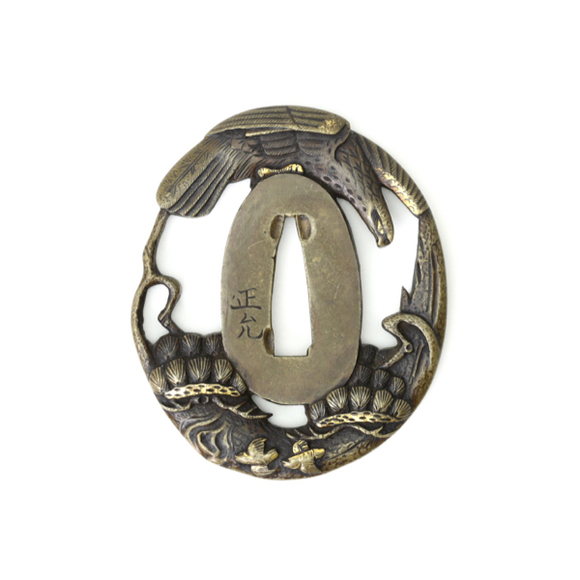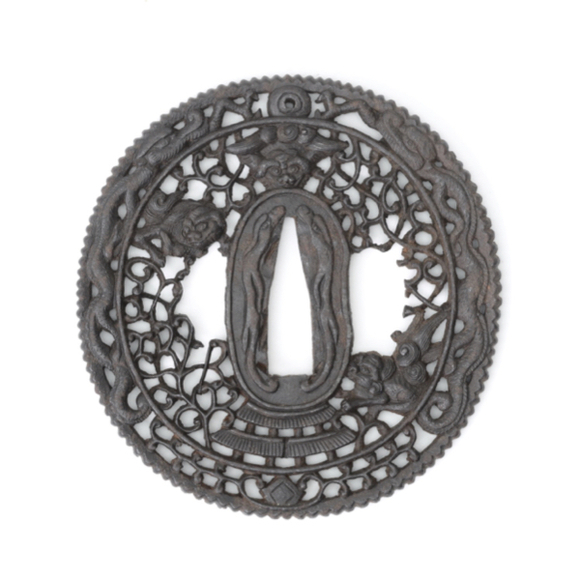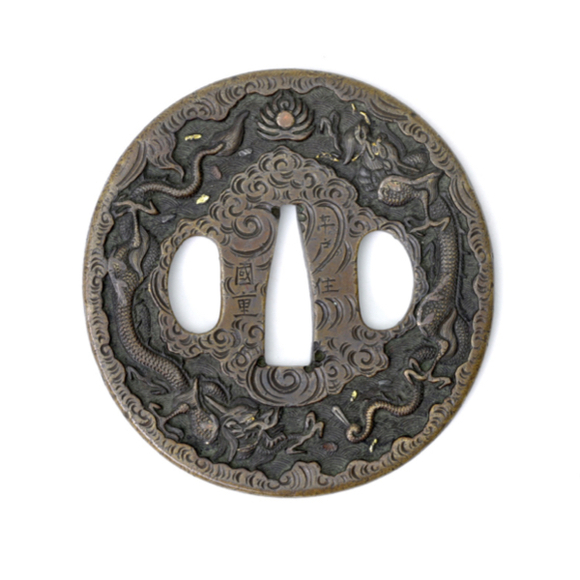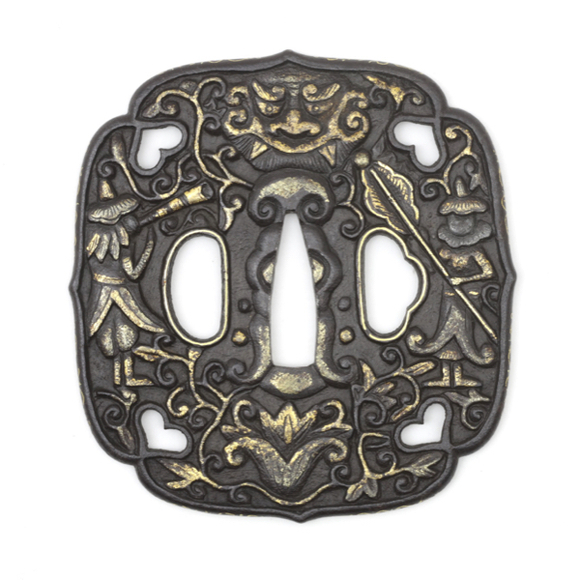Description
The bladesmith Muramasa of Ise has been a household name in Japan since the Edo period, mainly because they have been considered evil and cursed blades that hunger for blood. Muramasa has been featured in popular culture, from kabuki plays to pulp literature, firmly establishing his name and eerie reputation.
In this article, I want to focus on the bare facts we have on the origin and development of the curse.
For more information on the smith, see my glossary article: Muramasa (村正).
Muramasa of Ise
The name Muramasa has been engraved on sword tangs from around 1500 all the way into the 1660s. But when we speak of Muramasa and the curse, we are mainly speaking about the swords made in the town of Kuwana in Ise province, during the first decades of the 16th century.
These are generally thought to have been made by two generations of smiths, father and son. The father hailed from Mino and is believed to have been trained by Heianjō Nagayoshi and Izumo no Kami Kanesada.1
The second generation was the most skillful, however, Fujishiro believes these two generations may very well have been one and the same person who developed his mastery over a long active career.2
16th century Japan was caught up in an intense civil war where various factions were fighting over supremacy. Muramasa's blades were known for their fine craftsmanship and incredible sharpness, which made them popular among samurai of their day who expected to have to put them to use.
Notes
1. Markus Sesko; Swordsmiths of Japan. Revised and enlarged edition. Lulu Publishing. 2015. Pages 730-731.
2. Fujishiro Matsuo; Nihon Tōkō Jiten (日本刀工辞典). 1961. Translation by Harry Afu Watson.
The Curse of Muramasa
1535-1635, a century of unfortunate events
The idea of cursed Muramasa blades seems to have originated from a series of unfortunate events that struck the family of Tokugawa Ieyasu, the powerful warlord who ended over a century of civil war and would become the first Shōgun of Japan in 1600. These events unfolded after Muramasa's main active period of circa 1500-1530, and the smith himself was probably already dead or at least retired. In chronological order:
1535: Matsudaira Kiyoyasu, grandfather of Tokugawa Ieyasu, was cut down with a Muramasa katana. His body was said to be severed from shoulder to hip. The perpetrator was one of his own retainers, Abe Masatoyo, who mistakenly believed Kiyoyasu had sentenced his father to death.
Source: Mikawa Fudoki (参河風土記) or "Mikawa Gazetteer"
1543: Birth of Matsudaira Takechiyo, who would later become Tokugawa Ieyasu.
1545: Matsudaira Hirotada, father of Tokugawa Ieyasu, is stabbed in the thigh by a Muramasa tantō. The perpetrator did nothing else and ran away. He was samurai Iwamatsu Hachiya, vassal of the Tokugawa and a skilled warrior who had taken many heads in battles fought for the Tokugawa. The motif is unknown, but he was completely drunk and may have gone insane. Other theories are he was bribed to assassinate Hirotada.
1550s: Young Ieyasu cuts himself while playing with a Muramasa kogatana (a small knife).
Source: Tokugawa Jitsuki (徳川実紀) or "True Record of the Tokugawa"
A day-by-day record of the Tokugawa family history. Commissioned in 1799, completed 1844.
1579: Ieyasu orders his eldest son to commit seppuku, a ritual suicide by disembowelment, on grounds of suspicion of plotting against his lord, Oda Nobunaga. During seppuku, a second man is at the ready to decapitate the subject as an act of mercy. For this seppuku that man was chief counsellor Amagata Yamashiro no Kami, and the wakizashi he used was a Muramasa.
Source: Tokugawa Jitsuki (徳川実紀) or "True Record of the Tokugawa"
1600: During the Sekigahara Campaign one of Ieyasu's generals, Oda Yurokasai, offered the head of an enemy general for inspection to Ieyasu. His steel helmet was pierced through by a yari (spear) and so Ieyasu asked to see the spear that inflicted the admirable puncture. Ieyasu accidentally cut himself, and uttered: "this must be a Muramasa." Yurokasai confirmed. Upon hearing of Ieyasu's dislike for Muramasa blades, Yurokasai swore not to use them anymore and had the yari destroyed.
Source: Mikawa Go Fudoki (三河後風土記) or "Later Mikawa Gazetteer"
Based on old records. Compiled in 1832, revised in 1893.
Growing up hearing stories of grandfather being cut in two by his own retainer, father being stabbed by a crazy war hero, and then cutting himself with a knife by the same maker as the preceding events. Then having to order one's eldest son to commit suicide and learning that the final blow was by a Muramasa. You'll understand that by 1579, Muramasa blades really did give Ieyasu the creeps.
Tokugawa family misfortune involving Muramasa blades continued even after his death:
1633, Tokugawa Tadanaga, younger brother of the third Tokugawa-shōgun Iemitsu, was forced to take his own life. He used a Muramasa blade.
Source: Markus Sesko; The Curse of Muramasa
A Muramasa ban
Starting under Tokugawa Ieyasu, it is believed that Muramasa swords were banned.
1632, Nagasaki magistrate Takenaka Unemenosho Shigeyoshi and his son Genzaburo were arrested on suspicion of crimes. Initially, their punishment was banishment, but when their properties were seized, 24 Muramasa blades were found, upon which they were both sentenced to commit seppuku.
Afraid to face a similar fate, Muramasa owners started to carve away or alter the signatures on their blades. An act called kaisan (改鏨). Many Muramasa blades today have such altered signatures.
Some remained in circulation, though; kyōto-based sword polisher Imamura Yukimasa records polishing 10 Muramasa blades for clients during the period of 1804-1818.
Source: Markus Sesko; The Curse of Muramasa
Quoted from the Rekikan Kenshi (暦観剣志)
18th-century onwards
Popular culture
Writers of fiction began to get inspired by the Curse of Muramasa, and starting in the 18th century, various kabuki dramas were written concerning evil Muramasa swords:
1797: Sato Kotoba Awase Kagami by Namiki Gohei.
A play based on the historical event of samurai Sano Jirōzaemon murdering a hundred courtesans in Edo's red light district in 1696. In the play, it was his Muramasa sword that led him to this rage. It was a great success, and soon many more kabuki dramas emerged around Sano Jirōzaemon and his evil Muramasa blade.
1860: Hachiman Matsuri Yomiya no Nigiway by Kawatake Mokuami.
In this plot, Chijimiya Shinsuke kills a great number of geishas, the first he soon finds out to be his young sister from whom he has been separated since childhood. He realizes the Muramasa blade drove him to madness and ends up taking his own life.
1880: Koma no Hoshi Hakone no Shikabue by Kawatake Mokuami.
This time it is a Muramasa tantō that drives the protagonist mad and makes him kill a lot of people.
1882: Kirikogata Kyo no Benizome.
A dramatization of a Kyoto incident (the "daimaruya sodo incident") around a Muramasa katana.
1899: Akagoshi Chishio no Funakoshi.
The hero of this plot is driven to kill his own brother by his Muramasa sword, which could not be sheathed before drawing blood.

A Tale of Sano Jirōzaemon, Tsukioka Yoshitoshi, 1886.
Los Angeles County Museum of Art, accession number M.84.31.539a-b.
Notable Muramasa owners under the Tokugawa
It is believed that Muramasa swords were banned by the Tokugawa's starting at Ieyasu, but the relationship they had with them was a little more complicated. Despite the negative connotations, Muramasa blades remained prized throughout the Edo period. They were owned by many samurai, including those of the Tokugawa house themselves.
Tokugawa Ieyasu had a wonderful hitatsura (full-tempered) Muramasa katana that was kept in the family for generations and still exists today.
This sword is the subject of a documentary with Paul Martin
Nabeshima Katsushige (1580–1657), daimyō of Saga Domain, owned a Muramasa dated 1513. It is named Myōhō Muramasa (妙法村正) "Muramasa of the Sublime Dharma." It is kept in the Tokyo National Museum and is designated as a Juyō Bunkazai (重要文化財) "Important Art Object".
Muramasa signed (勢州桑名住村正), Tokyo National Museum
Tokugawa Yoshinobu, the last shōgun of Japan, owned a daishō of which the katana is a Muramasa.
This sword is in the Metropolitan Museum, accession number 36.120.412a, b
Gift of Howard Mansfield
Matsudaira Geki was a strong but junior samurai who served as a guard at Edo castle. He was bullied by his seniors and in 1823, he snapped and killed three men and wounded two with his katana. Honda Iori's head was cut off clean, Toda Hokinoshin was cut diagonally across the shoulder, and Numata Sakyo was slashed across the waist. Kamio Goro and Mabe Genjuri were cut while fleeing but survived. He committed seppuku after the act, at age 33. Some sources say the sword he used was a Muramasa.
Source: Albert Yamanaka's Nihontō Newsletter. Volume 3, page 29.
Yamada Asaemon Yoshimutsu (山田浅右衛門吉睦), who did the famous wazamono ratings published in the Kokon Kaj Bikō (古今鍛治備考) of 1829 wore a tantō by Muramasa. This dagger was formerly in the possession of Iga Shirazaemon. It had the Mura character removed, and only retained the Masa (正). It speaks volumes that Japan's most noted sword tester of his day relied on a Muramasa tantō himself.
Source: Joly and Hogitaro; The Sword and Samé. Holland Press, 1962. Page 70.
Conclusion
From this summary of facts, we can gather that Muramasa swords indeed gave Tokugawa Ieyasu the creeps, but not enough for him to give up his own prized blade. It seems he rather did not have anyone near him to wear one, out of fear it would turn against him or one of his family members.
From his time onwards, though, the legends spun out of control to the point that the curse was deeply embedded into the minds of every Japanese household.
At the highest levels, however, they were still prized for their workmanship. The last Tokugawa shōgun as well as one of the empire's best sword testers, defied the curse by still relying on their Muramasa blades.







